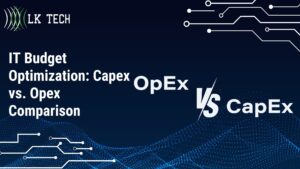Optimizing Your IT Budget: Capex vs. Opex
When allocating your IT budget, understanding the differences between capital expenditures (Capex) and operational expenditures (Opex) is key. This article examines Capex vs. Opex in-depth to help you make informed decisions and optimize IT investments.

- IT Budget Optimization: Capex vs. Opex Comparison
What Are Capital Expenditures (Capex)?
Capital expenditures (Capex) refer to major upfront investments in IT infrastructure and assets. Examples of common Capex expenditures include:
- Purchasing new servers and data center hardware. Servers are a foundational IT asset for hosting applications, websites, databases, and more. Investing in new, high-performance servers provides processing power and storage capacity to support business operations.
- Buying perpetual software licenses. Many software applications are purchased through large, one-time license fees that grant you ownership of the software. Common examples are productivity suites like Microsoft Office or infrastructure software like Windows Server.
- Investing in laptops, desktops, printers, and other IT equipment. Outfitting an office with new computers, devices, and peripherals is a significant Capex outlay.
- Building or expanding facilities to house IT infrastructure. Constructing a new data center or server room requires major capital allocated to real estate, construction, electrical, and cooling.
The main advantage of Capex is ownership and control. With Capex investments, you fully own the IT assets and can use them over long periods rather than relying on vendors. There's no need to make recurring payments or renew licenses and subscriptions. You also have total control over the technology infrastructure without restrictions from vendors.
However, Capex also comes with notable disadvantages:
- Requires large upfront costs, putting a strain on budgets. Capex often entails very high one-time costs that can be difficult to finance. It takes time to see ROI on major infrastructure projects.
- Assets like servers and software can become outdated quickly as technology advances. A server that is state-of-the-art today may become obsolete in just 3-5 years.
- Hard to accurately predict future business needs, risk of over or under buying. A Capex investment made today needs to support operations 5+ years into the future, which is difficult to plan for.
Overall, Capex is best suited for established companies with relatively stable IT needs and growth plans. Capex gives you full control over your technology assets, but the large upfront costs and risk of outdated gear makes it less ideal for rapidly changing businesses.
What Are Operational Expenditures (Opex)?
Operational expenditures (Opex) refer to ongoing IT expenses that are paid for on a subscription or as-needed basis, rather than large upfront costs. Examples of common Opex expenses include:
- Cloud computing services like Amazon AWS, Microsoft Azure, or Google Cloud Platform. With cloud services, you pay-as-you-go based on real usage rather than owning the underlying infrastructure.
- Software-as-a-Service (SaaS) applications like Office 365, Salesforce, Workday, and many more. SaaS apps are paid for through monthly or annual subscriptions, allowing you to scale usage up and down.
- Managed IT services provided by a third-party. Managed service providers handle tasks like 24/7 monitoring, security, backups, and support for a predictable fee.
- IT equipment leasing. Leasing computers, servers, printers or other gear means you pay regular fees but don't own the assets outright.
With Opex, you pay for IT resources as you use them month-to-month or year-over-year. This provides great flexibility as your business operations and technology needs inevitably evolve. You can easily scale services and spending up or down as needed.
Benefits of the Opex model include:
- No large upfront Capex outlays required. This conserves cash flow for other business priorities.
- Ability to adjust IT spending based on changing needs. With SaaS and cloud, it's easy to add or remove licenses and capacity quickly.
- Access to the latest technology through regular upgrades. Cloud and SaaS vendors continuously update their platforms, so you get a steady stream of new features.
- Predictable expenses that can be budgeted for. Since Opex is subscription-based, the ongoing costs are known.
The main risks of Opex revolve around vendor dependence. With Opex, you don't own the IT assets. If you cancel a SaaS subscription, you lose access to that software and data. If you reduce cloud infrastructure, you may lose capacity.
Due to its flexibility and scalability, Opex is very well suited for growing companies with evolving IT needs. It provides access to best-of-breed technology without major upfront investments. Opex spending tends to rise in growth periods and fall during tougher times.
Mature companies can utilize Opex for new projects and experiments where needs are less defined. Large enterprises often find a blended Opex/Capex approach provides the right balance.
Key Differences Between Capex and Opex
In summary, the key differences between the Capex and Opex approaches are:
Capex
- Large upfront costs
- Own and control physical IT assets
- Assets can become outdated or unnecessary
- Difficult to forecast long-term needs
Opex
- Pay-as-you-go costs, no large upfront outlays
- Flexibility to scale IT resources up and down
- Access to latest technology through vendor upgrades
- Do not own the underlying IT assets
Ownership is a major distinction. With Capex, you own equipment like servers and have full control. With Opex, you rely on vendors to provide technology services and must accept their terms.
But both approaches have benefits depending on the use case. Many successful IT strategies incorporate a blend of Capex and Opex spending tailored to business goals.
Choosing Between Capex vs. Opex
Deciding between prioritizing Capex or Opex requires a close analysis of your IT environment and business objectives. Consider the following factors:
Budget - Capex requires large amounts of available capital to purchase assets upfront. Opex is generally easier to manage cash flows around, avoiding large one-time costs.
Existing Infrastructure - If you have aging hardware and software due for a major refresh, Capex investments make sense. Opex better suits adding capacity and new capabilities.
Growth Trajectory - Opex provides maximum flexibility to scale IT resources up or down as needs evolve. It is ideal for high-growth companies whose needs are rapidly changing.
Ownership Philosophy - Capex is optimal if you strongly prefer owning and controlling the physical IT assets. With Opex, you relinquish ownership which may be unappealing.
In-House vs Outsourced IT - Capex requires skilled in-house staff to manage purchased infrastructure. Opex outsources more day-to-day responsibility to vendors.
Security and Compliance - Capex may provide stronger oversight for sensitive data. Cloud and SaaS vendors force you to accept their security model.
Innovation Priorities - Opex provides faster access to latest technology. With Capex you’re stuck managing what you purchased until the next refresh cycle.
Carefully analyzing these factors will guide your Capex versus Opex decision. In many cases, a blended approach makes the most sense. Capex for foundational infrastructure while utilizing Opex for agility and innovation.

- IT Budget Optimization: Capex vs. Opex Comparison
Optimize Your IT Investments
Optimizing IT investments is a complex, ongoing process. Both Capex and Opex have roles to play depending on your strategy. Here are some best practices:
- Take a holistic view of business goals before prioritizing tech investments. Align spending to initiatives with the highest ROI.
- Involve finance early in IT planning. Coordinate on budget trade-offs and models that balance Capex/Opex.
- Phase large Capex projects to spread costs over time. For example build a new data center in planned stages rather than all upfront.
- Leverage Opex for pilot projects before major Capex. Prove the value before large infrastructure commitments.
- Manage Capex assets for maximum lifetime through maintenance and upgrades. Sweat these investments before replacing.
- Analyze workloads and usage to right-size Opex services. Add/remove cloud capacity and SaaS licenses based on data.
- Maintain IT agility. Give preference to flexible consumption models that can scale, even if at a premium.
An experienced managed IT services provider based in Cincinnati, Ohio like LK Technologies can offer guidance on aligning your budget with business goals. Managed service providers have experience architecting and running blended Capex/Opex environments tailored to each client’s needs.
Contact us for help assessing your infrastructure and technology spending strategy. We can provide actionable recommendations on optimizing IT investments for supporting your business objectives.


